BP Oil Spill: Systems Engineering, Risk, and Life Cycle Analysis
VerifiedAdded on 2023/06/11
|11
|2908
|255
Essay
AI Summary
This essay examines the Deepwater Horizon oil spill through the lens of systems engineering, focusing on systems lifecycle processes and general systems management principles. It discusses the role of organizational structures, forms, and culture, highlighting deficiencies in communication and information sharing within BP that contributed to the disaster. The analysis extends to engineering risk and risk management, emphasizing the importance of safety audits and various risk identification techniques. Portfolio alignment and business value are also considered, noting the damage to BP's reputation and the need for effective portfolio management post-incident. The essay further explores organizational maturity and the tools and techniques of systems thinking, suggesting how these could have been applied to prevent the catastrophe. It concludes by underscoring the necessity of robust management systems and offering recommendations for preventing similar incidents in the future, with Desklib offering further resources for students.
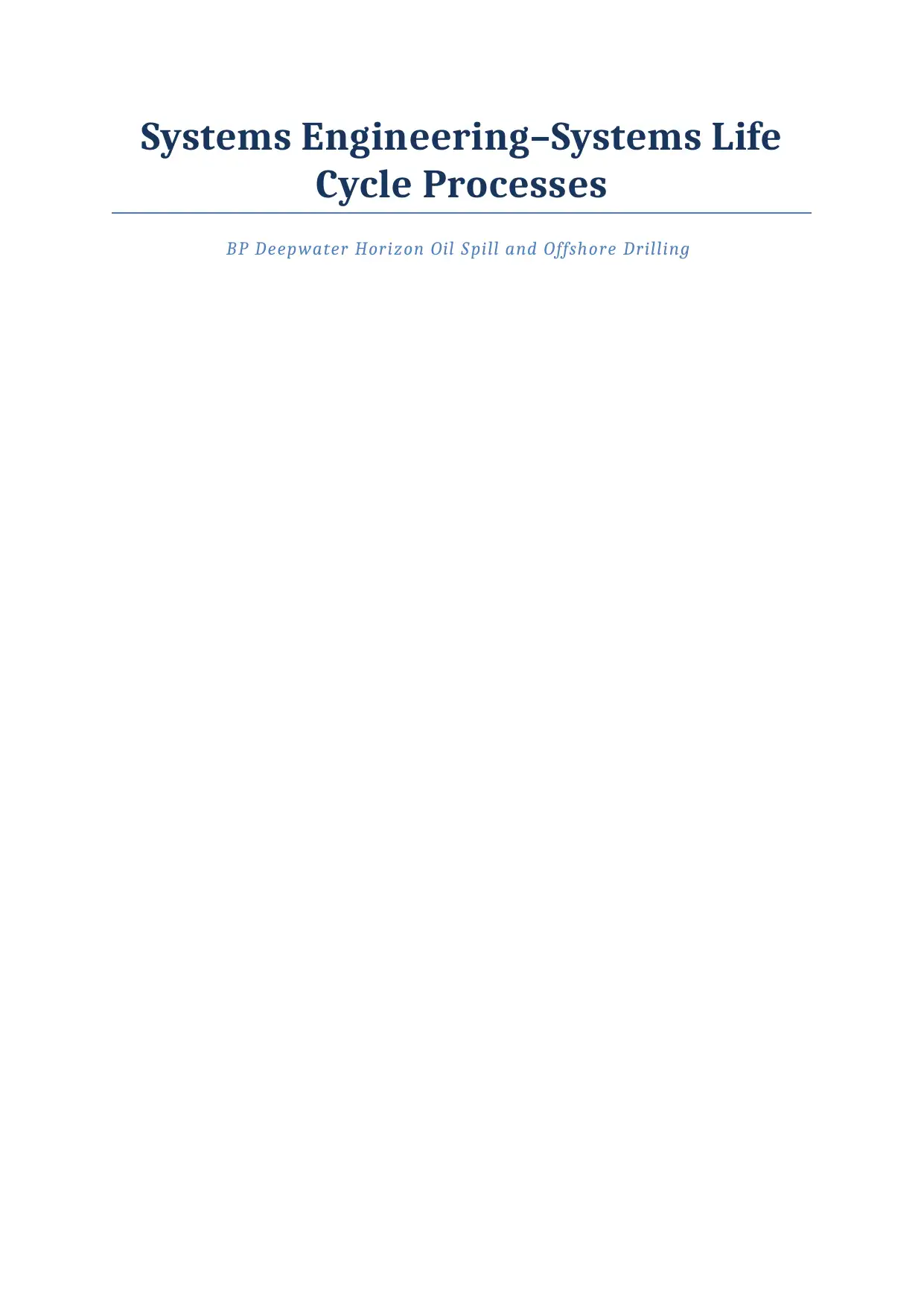
Systems Engineering–Systems Life
Cycle Processes
BP Deepwater Horizon Oil Spill and Offshore Drilling
Cycle Processes
BP Deepwater Horizon Oil Spill and Offshore Drilling
Paraphrase This Document
Need a fresh take? Get an instant paraphrase of this document with our AI Paraphraser
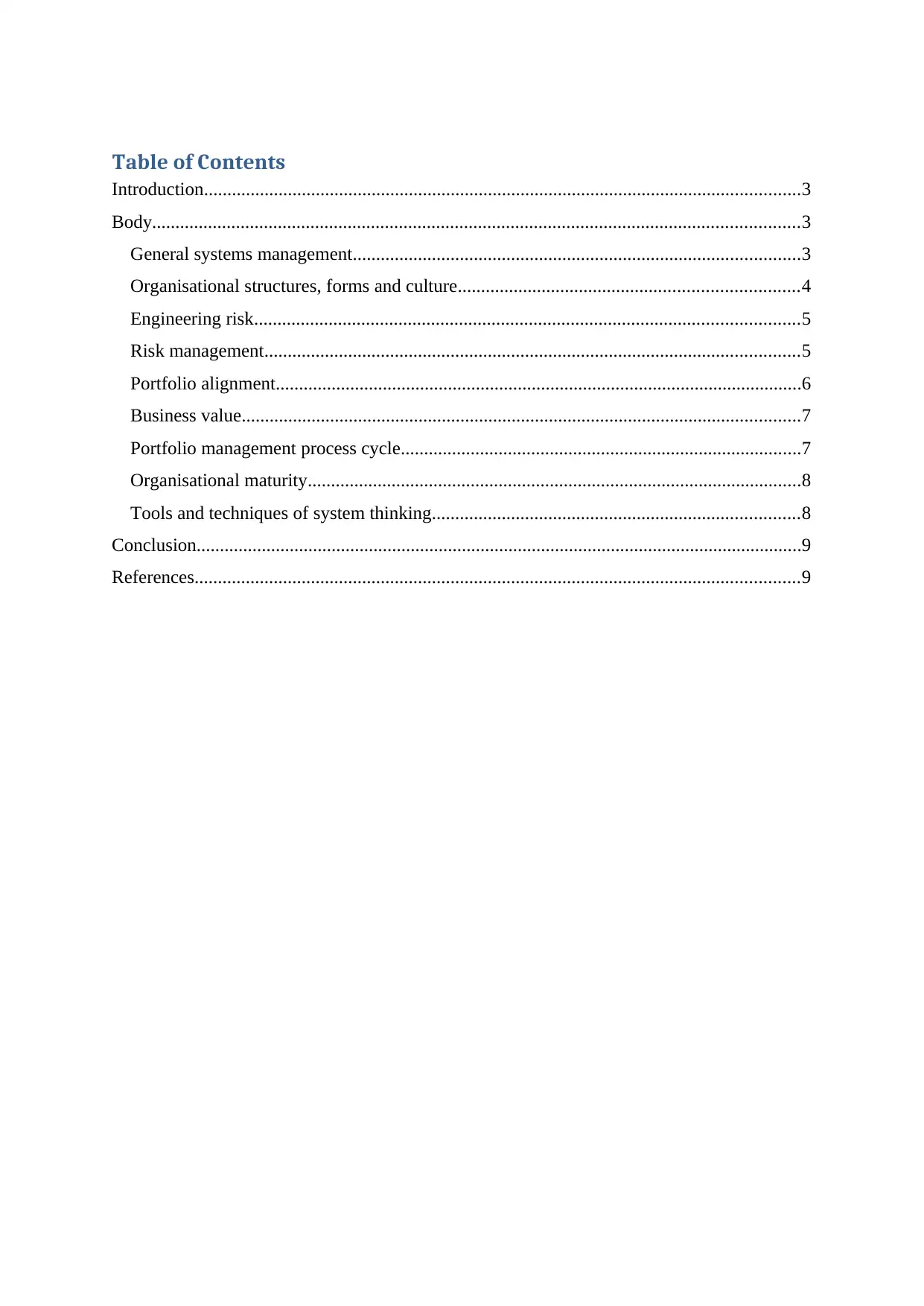
Table of Contents
Introduction................................................................................................................................3
Body...........................................................................................................................................3
General systems management................................................................................................3
Organisational structures, forms and culture.........................................................................4
Engineering risk.....................................................................................................................5
Risk management...................................................................................................................5
Portfolio alignment.................................................................................................................6
Business value........................................................................................................................7
Portfolio management process cycle......................................................................................7
Organisational maturity..........................................................................................................8
Tools and techniques of system thinking...............................................................................8
Conclusion..................................................................................................................................9
References..................................................................................................................................9
Introduction................................................................................................................................3
Body...........................................................................................................................................3
General systems management................................................................................................3
Organisational structures, forms and culture.........................................................................4
Engineering risk.....................................................................................................................5
Risk management...................................................................................................................5
Portfolio alignment.................................................................................................................6
Business value........................................................................................................................7
Portfolio management process cycle......................................................................................7
Organisational maturity..........................................................................................................8
Tools and techniques of system thinking...............................................................................8
Conclusion..................................................................................................................................9
References..................................................................................................................................9
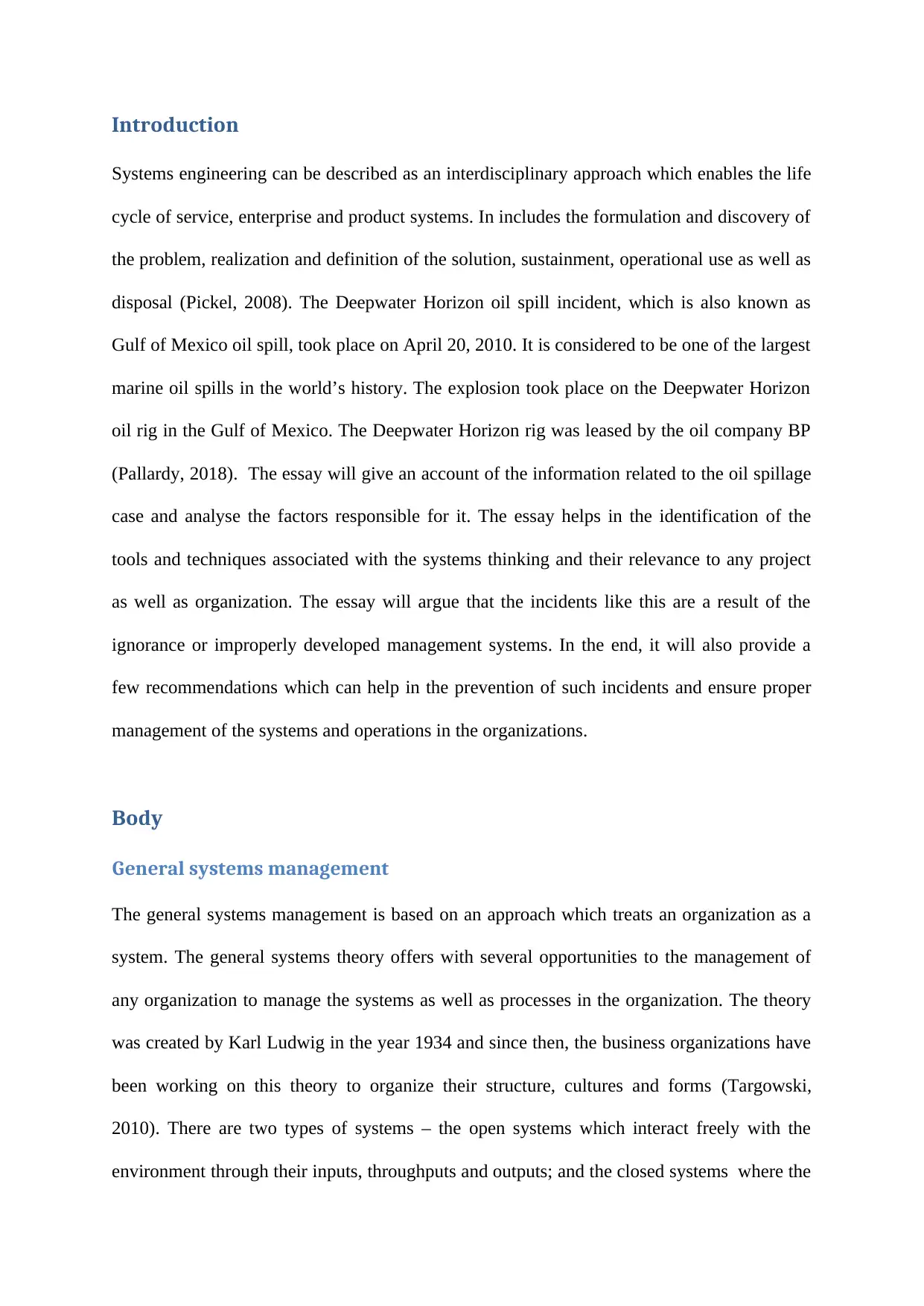
Introduction
Systems engineering can be described as an interdisciplinary approach which enables the life
cycle of service, enterprise and product systems. In includes the formulation and discovery of
the problem, realization and definition of the solution, sustainment, operational use as well as
disposal (Pickel, 2008). The Deepwater Horizon oil spill incident, which is also known as
Gulf of Mexico oil spill, took place on April 20, 2010. It is considered to be one of the largest
marine oil spills in the world’s history. The explosion took place on the Deepwater Horizon
oil rig in the Gulf of Mexico. The Deepwater Horizon rig was leased by the oil company BP
(Pallardy, 2018). The essay will give an account of the information related to the oil spillage
case and analyse the factors responsible for it. The essay helps in the identification of the
tools and techniques associated with the systems thinking and their relevance to any project
as well as organization. The essay will argue that the incidents like this are a result of the
ignorance or improperly developed management systems. In the end, it will also provide a
few recommendations which can help in the prevention of such incidents and ensure proper
management of the systems and operations in the organizations.
Body
General systems management
The general systems management is based on an approach which treats an organization as a
system. The general systems theory offers with several opportunities to the management of
any organization to manage the systems as well as processes in the organization. The theory
was created by Karl Ludwig in the year 1934 and since then, the business organizations have
been working on this theory to organize their structure, cultures and forms (Targowski,
2010). There are two types of systems – the open systems which interact freely with the
environment through their inputs, throughputs and outputs; and the closed systems where the
Systems engineering can be described as an interdisciplinary approach which enables the life
cycle of service, enterprise and product systems. In includes the formulation and discovery of
the problem, realization and definition of the solution, sustainment, operational use as well as
disposal (Pickel, 2008). The Deepwater Horizon oil spill incident, which is also known as
Gulf of Mexico oil spill, took place on April 20, 2010. It is considered to be one of the largest
marine oil spills in the world’s history. The explosion took place on the Deepwater Horizon
oil rig in the Gulf of Mexico. The Deepwater Horizon rig was leased by the oil company BP
(Pallardy, 2018). The essay will give an account of the information related to the oil spillage
case and analyse the factors responsible for it. The essay helps in the identification of the
tools and techniques associated with the systems thinking and their relevance to any project
as well as organization. The essay will argue that the incidents like this are a result of the
ignorance or improperly developed management systems. In the end, it will also provide a
few recommendations which can help in the prevention of such incidents and ensure proper
management of the systems and operations in the organizations.
Body
General systems management
The general systems management is based on an approach which treats an organization as a
system. The general systems theory offers with several opportunities to the management of
any organization to manage the systems as well as processes in the organization. The theory
was created by Karl Ludwig in the year 1934 and since then, the business organizations have
been working on this theory to organize their structure, cultures and forms (Targowski,
2010). There are two types of systems – the open systems which interact freely with the
environment through their inputs, throughputs and outputs; and the closed systems where the
⊘ This is a preview!⊘
Do you want full access?
Subscribe today to unlock all pages.

Trusted by 1+ million students worldwide
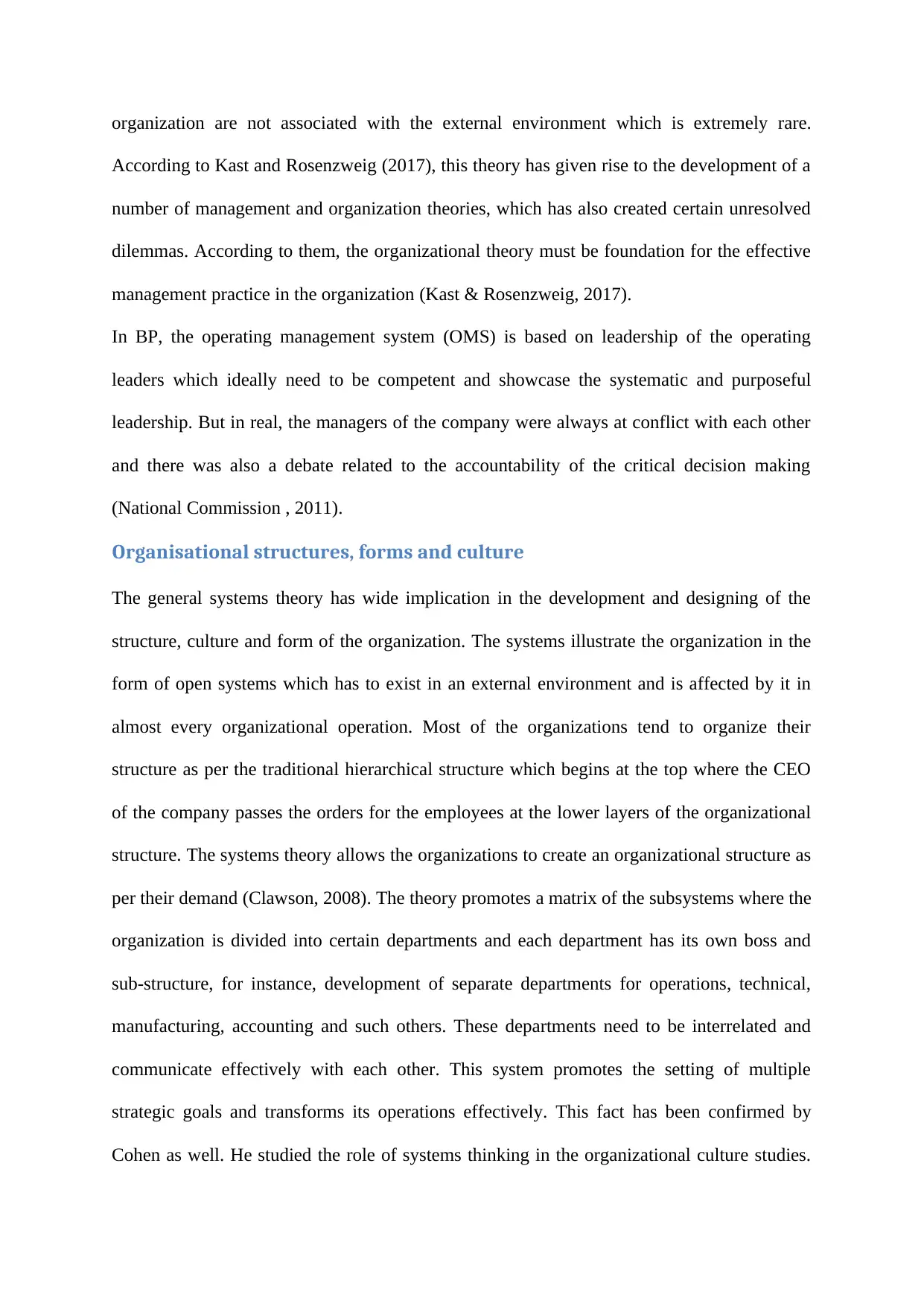
organization are not associated with the external environment which is extremely rare.
According to Kast and Rosenzweig (2017), this theory has given rise to the development of a
number of management and organization theories, which has also created certain unresolved
dilemmas. According to them, the organizational theory must be foundation for the effective
management practice in the organization (Kast & Rosenzweig, 2017).
In BP, the operating management system (OMS) is based on leadership of the operating
leaders which ideally need to be competent and showcase the systematic and purposeful
leadership. But in real, the managers of the company were always at conflict with each other
and there was also a debate related to the accountability of the critical decision making
(National Commission , 2011).
Organisational structures, forms and culture
The general systems theory has wide implication in the development and designing of the
structure, culture and form of the organization. The systems illustrate the organization in the
form of open systems which has to exist in an external environment and is affected by it in
almost every organizational operation. Most of the organizations tend to organize their
structure as per the traditional hierarchical structure which begins at the top where the CEO
of the company passes the orders for the employees at the lower layers of the organizational
structure. The systems theory allows the organizations to create an organizational structure as
per their demand (Clawson, 2008). The theory promotes a matrix of the subsystems where the
organization is divided into certain departments and each department has its own boss and
sub-structure, for instance, development of separate departments for operations, technical,
manufacturing, accounting and such others. These departments need to be interrelated and
communicate effectively with each other. This system promotes the setting of multiple
strategic goals and transforms its operations effectively. This fact has been confirmed by
Cohen as well. He studied the role of systems thinking in the organizational culture studies.
According to Kast and Rosenzweig (2017), this theory has given rise to the development of a
number of management and organization theories, which has also created certain unresolved
dilemmas. According to them, the organizational theory must be foundation for the effective
management practice in the organization (Kast & Rosenzweig, 2017).
In BP, the operating management system (OMS) is based on leadership of the operating
leaders which ideally need to be competent and showcase the systematic and purposeful
leadership. But in real, the managers of the company were always at conflict with each other
and there was also a debate related to the accountability of the critical decision making
(National Commission , 2011).
Organisational structures, forms and culture
The general systems theory has wide implication in the development and designing of the
structure, culture and form of the organization. The systems illustrate the organization in the
form of open systems which has to exist in an external environment and is affected by it in
almost every organizational operation. Most of the organizations tend to organize their
structure as per the traditional hierarchical structure which begins at the top where the CEO
of the company passes the orders for the employees at the lower layers of the organizational
structure. The systems theory allows the organizations to create an organizational structure as
per their demand (Clawson, 2008). The theory promotes a matrix of the subsystems where the
organization is divided into certain departments and each department has its own boss and
sub-structure, for instance, development of separate departments for operations, technical,
manufacturing, accounting and such others. These departments need to be interrelated and
communicate effectively with each other. This system promotes the setting of multiple
strategic goals and transforms its operations effectively. This fact has been confirmed by
Cohen as well. He studied the role of systems thinking in the organizational culture studies.
Paraphrase This Document
Need a fresh take? Get an instant paraphrase of this document with our AI Paraphraser
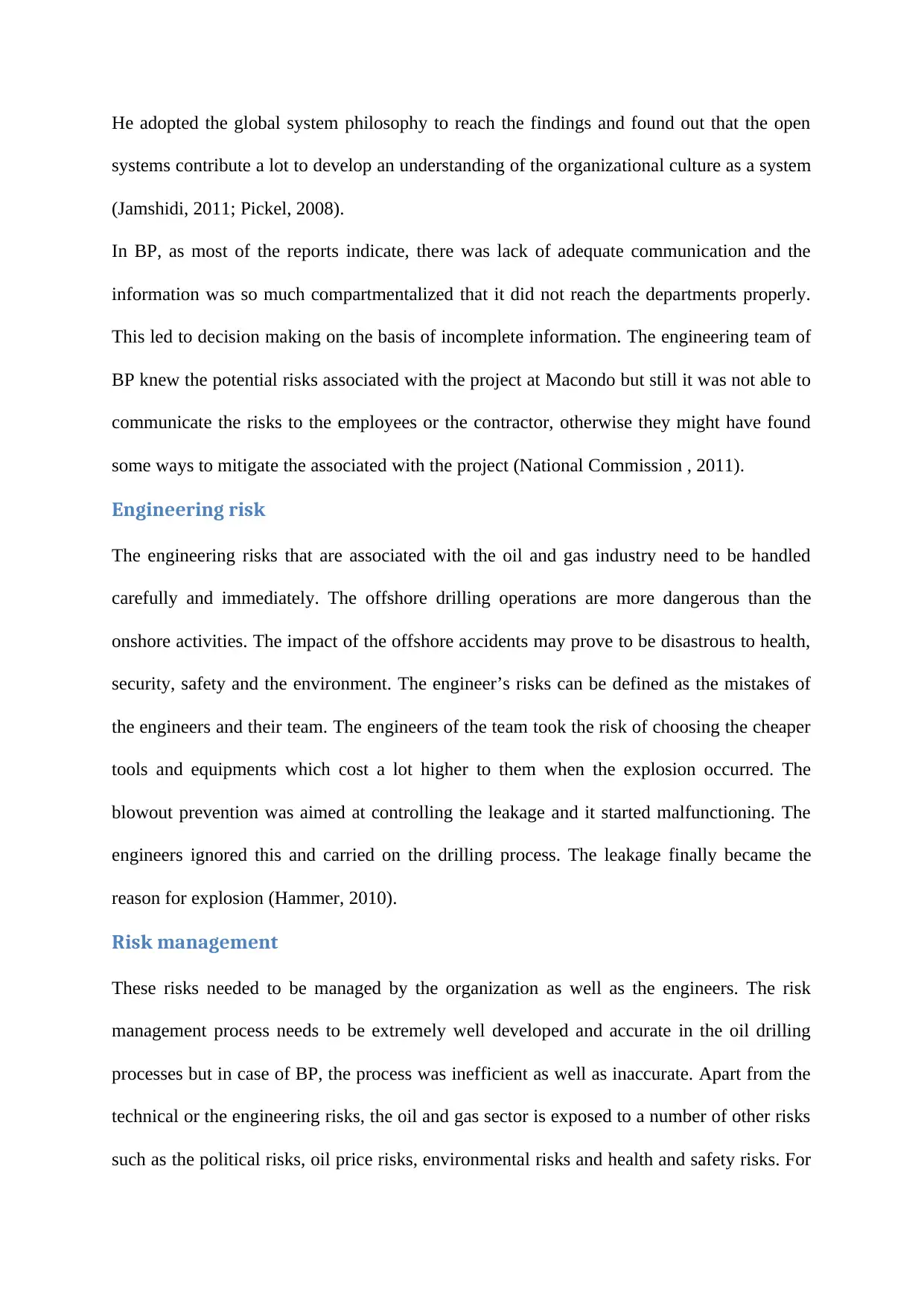
He adopted the global system philosophy to reach the findings and found out that the open
systems contribute a lot to develop an understanding of the organizational culture as a system
(Jamshidi, 2011; Pickel, 2008).
In BP, as most of the reports indicate, there was lack of adequate communication and the
information was so much compartmentalized that it did not reach the departments properly.
This led to decision making on the basis of incomplete information. The engineering team of
BP knew the potential risks associated with the project at Macondo but still it was not able to
communicate the risks to the employees or the contractor, otherwise they might have found
some ways to mitigate the associated with the project (National Commission , 2011).
Engineering risk
The engineering risks that are associated with the oil and gas industry need to be handled
carefully and immediately. The offshore drilling operations are more dangerous than the
onshore activities. The impact of the offshore accidents may prove to be disastrous to health,
security, safety and the environment. The engineer’s risks can be defined as the mistakes of
the engineers and their team. The engineers of the team took the risk of choosing the cheaper
tools and equipments which cost a lot higher to them when the explosion occurred. The
blowout prevention was aimed at controlling the leakage and it started malfunctioning. The
engineers ignored this and carried on the drilling process. The leakage finally became the
reason for explosion (Hammer, 2010).
Risk management
These risks needed to be managed by the organization as well as the engineers. The risk
management process needs to be extremely well developed and accurate in the oil drilling
processes but in case of BP, the process was inefficient as well as inaccurate. Apart from the
technical or the engineering risks, the oil and gas sector is exposed to a number of other risks
such as the political risks, oil price risks, environmental risks and health and safety risks. For
systems contribute a lot to develop an understanding of the organizational culture as a system
(Jamshidi, 2011; Pickel, 2008).
In BP, as most of the reports indicate, there was lack of adequate communication and the
information was so much compartmentalized that it did not reach the departments properly.
This led to decision making on the basis of incomplete information. The engineering team of
BP knew the potential risks associated with the project at Macondo but still it was not able to
communicate the risks to the employees or the contractor, otherwise they might have found
some ways to mitigate the associated with the project (National Commission , 2011).
Engineering risk
The engineering risks that are associated with the oil and gas industry need to be handled
carefully and immediately. The offshore drilling operations are more dangerous than the
onshore activities. The impact of the offshore accidents may prove to be disastrous to health,
security, safety and the environment. The engineer’s risks can be defined as the mistakes of
the engineers and their team. The engineers of the team took the risk of choosing the cheaper
tools and equipments which cost a lot higher to them when the explosion occurred. The
blowout prevention was aimed at controlling the leakage and it started malfunctioning. The
engineers ignored this and carried on the drilling process. The leakage finally became the
reason for explosion (Hammer, 2010).
Risk management
These risks needed to be managed by the organization as well as the engineers. The risk
management process needs to be extremely well developed and accurate in the oil drilling
processes but in case of BP, the process was inefficient as well as inaccurate. Apart from the
technical or the engineering risks, the oil and gas sector is exposed to a number of other risks
such as the political risks, oil price risks, environmental risks and health and safety risks. For
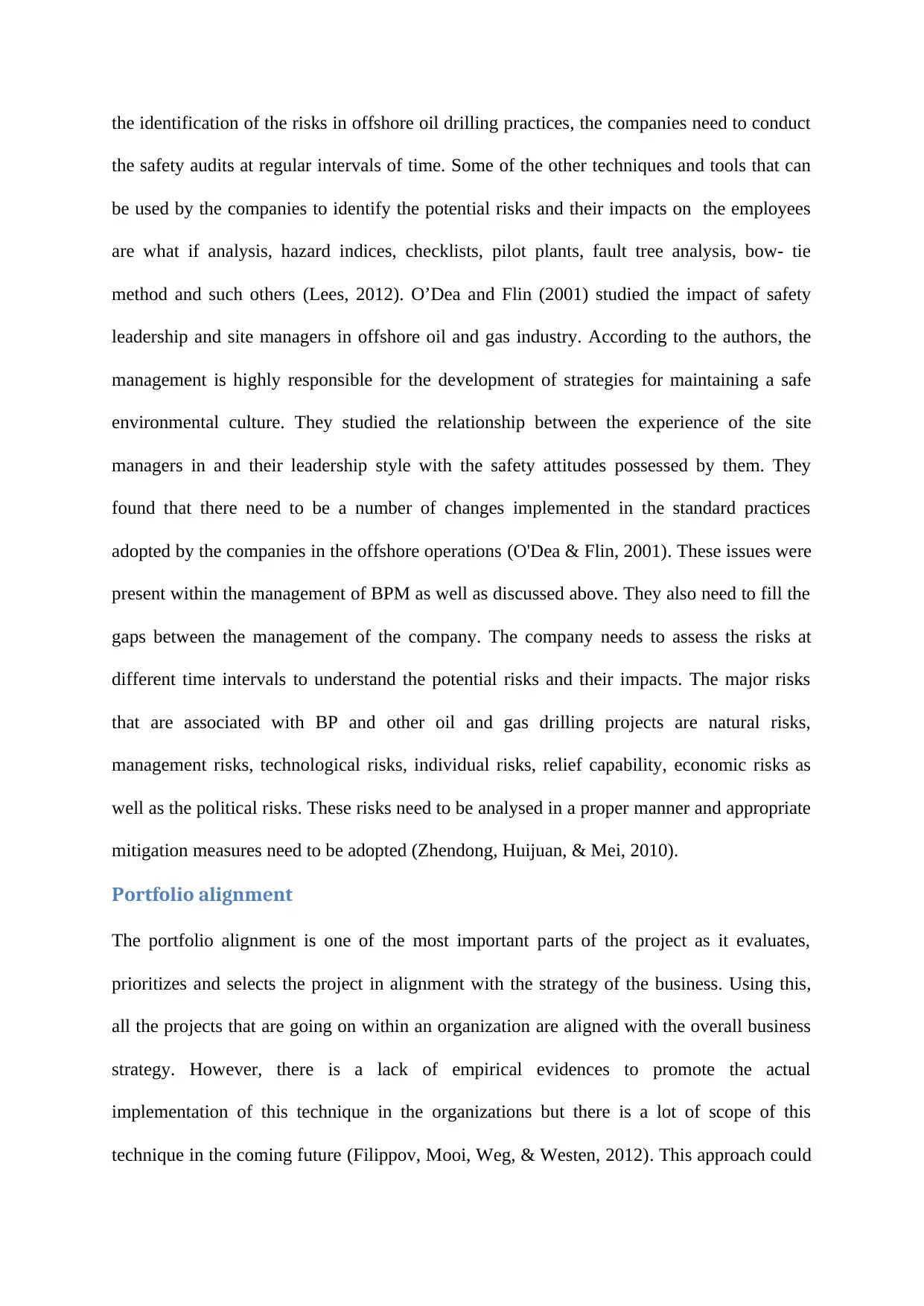
the identification of the risks in offshore oil drilling practices, the companies need to conduct
the safety audits at regular intervals of time. Some of the other techniques and tools that can
be used by the companies to identify the potential risks and their impacts on the employees
are what if analysis, hazard indices, checklists, pilot plants, fault tree analysis, bow- tie
method and such others (Lees, 2012). O’Dea and Flin (2001) studied the impact of safety
leadership and site managers in offshore oil and gas industry. According to the authors, the
management is highly responsible for the development of strategies for maintaining a safe
environmental culture. They studied the relationship between the experience of the site
managers in and their leadership style with the safety attitudes possessed by them. They
found that there need to be a number of changes implemented in the standard practices
adopted by the companies in the offshore operations (O'Dea & Flin, 2001). These issues were
present within the management of BPM as well as discussed above. They also need to fill the
gaps between the management of the company. The company needs to assess the risks at
different time intervals to understand the potential risks and their impacts. The major risks
that are associated with BP and other oil and gas drilling projects are natural risks,
management risks, technological risks, individual risks, relief capability, economic risks as
well as the political risks. These risks need to be analysed in a proper manner and appropriate
mitigation measures need to be adopted (Zhendong, Huijuan, & Mei, 2010).
Portfolio alignment
The portfolio alignment is one of the most important parts of the project as it evaluates,
prioritizes and selects the project in alignment with the strategy of the business. Using this,
all the projects that are going on within an organization are aligned with the overall business
strategy. However, there is a lack of empirical evidences to promote the actual
implementation of this technique in the organizations but there is a lot of scope of this
technique in the coming future (Filippov, Mooi, Weg, & Westen, 2012). This approach could
the safety audits at regular intervals of time. Some of the other techniques and tools that can
be used by the companies to identify the potential risks and their impacts on the employees
are what if analysis, hazard indices, checklists, pilot plants, fault tree analysis, bow- tie
method and such others (Lees, 2012). O’Dea and Flin (2001) studied the impact of safety
leadership and site managers in offshore oil and gas industry. According to the authors, the
management is highly responsible for the development of strategies for maintaining a safe
environmental culture. They studied the relationship between the experience of the site
managers in and their leadership style with the safety attitudes possessed by them. They
found that there need to be a number of changes implemented in the standard practices
adopted by the companies in the offshore operations (O'Dea & Flin, 2001). These issues were
present within the management of BPM as well as discussed above. They also need to fill the
gaps between the management of the company. The company needs to assess the risks at
different time intervals to understand the potential risks and their impacts. The major risks
that are associated with BP and other oil and gas drilling projects are natural risks,
management risks, technological risks, individual risks, relief capability, economic risks as
well as the political risks. These risks need to be analysed in a proper manner and appropriate
mitigation measures need to be adopted (Zhendong, Huijuan, & Mei, 2010).
Portfolio alignment
The portfolio alignment is one of the most important parts of the project as it evaluates,
prioritizes and selects the project in alignment with the strategy of the business. Using this,
all the projects that are going on within an organization are aligned with the overall business
strategy. However, there is a lack of empirical evidences to promote the actual
implementation of this technique in the organizations but there is a lot of scope of this
technique in the coming future (Filippov, Mooi, Weg, & Westen, 2012). This approach could
⊘ This is a preview!⊘
Do you want full access?
Subscribe today to unlock all pages.

Trusted by 1+ million students worldwide
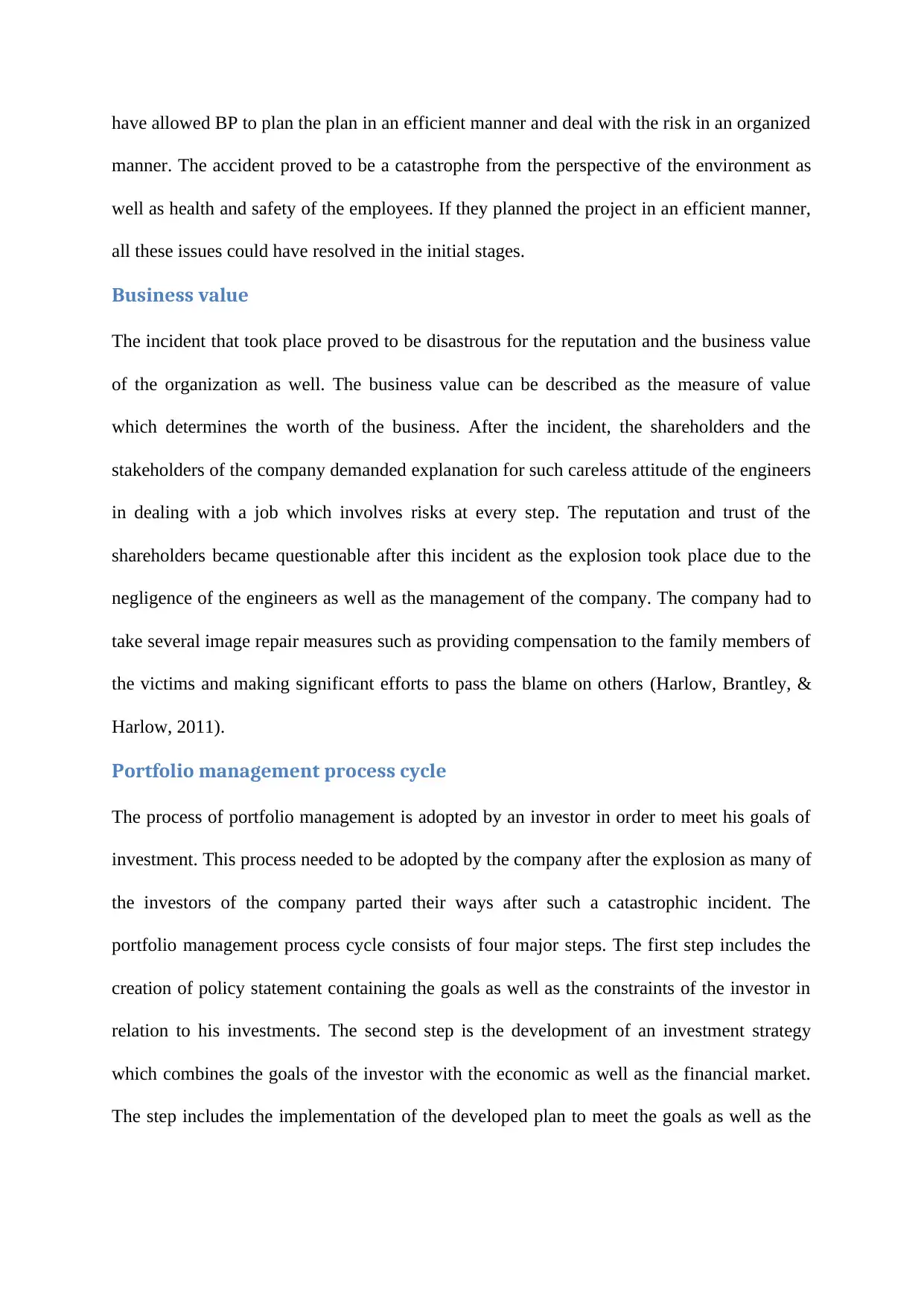
have allowed BP to plan the plan in an efficient manner and deal with the risk in an organized
manner. The accident proved to be a catastrophe from the perspective of the environment as
well as health and safety of the employees. If they planned the project in an efficient manner,
all these issues could have resolved in the initial stages.
Business value
The incident that took place proved to be disastrous for the reputation and the business value
of the organization as well. The business value can be described as the measure of value
which determines the worth of the business. After the incident, the shareholders and the
stakeholders of the company demanded explanation for such careless attitude of the engineers
in dealing with a job which involves risks at every step. The reputation and trust of the
shareholders became questionable after this incident as the explosion took place due to the
negligence of the engineers as well as the management of the company. The company had to
take several image repair measures such as providing compensation to the family members of
the victims and making significant efforts to pass the blame on others (Harlow, Brantley, &
Harlow, 2011).
Portfolio management process cycle
The process of portfolio management is adopted by an investor in order to meet his goals of
investment. This process needed to be adopted by the company after the explosion as many of
the investors of the company parted their ways after such a catastrophic incident. The
portfolio management process cycle consists of four major steps. The first step includes the
creation of policy statement containing the goals as well as the constraints of the investor in
relation to his investments. The second step is the development of an investment strategy
which combines the goals of the investor with the economic as well as the financial market.
The step includes the implementation of the developed plan to meet the goals as well as the
manner. The accident proved to be a catastrophe from the perspective of the environment as
well as health and safety of the employees. If they planned the project in an efficient manner,
all these issues could have resolved in the initial stages.
Business value
The incident that took place proved to be disastrous for the reputation and the business value
of the organization as well. The business value can be described as the measure of value
which determines the worth of the business. After the incident, the shareholders and the
stakeholders of the company demanded explanation for such careless attitude of the engineers
in dealing with a job which involves risks at every step. The reputation and trust of the
shareholders became questionable after this incident as the explosion took place due to the
negligence of the engineers as well as the management of the company. The company had to
take several image repair measures such as providing compensation to the family members of
the victims and making significant efforts to pass the blame on others (Harlow, Brantley, &
Harlow, 2011).
Portfolio management process cycle
The process of portfolio management is adopted by an investor in order to meet his goals of
investment. This process needed to be adopted by the company after the explosion as many of
the investors of the company parted their ways after such a catastrophic incident. The
portfolio management process cycle consists of four major steps. The first step includes the
creation of policy statement containing the goals as well as the constraints of the investor in
relation to his investments. The second step is the development of an investment strategy
which combines the goals of the investor with the economic as well as the financial market.
The step includes the implementation of the developed plan to meet the goals as well as the
Paraphrase This Document
Need a fresh take? Get an instant paraphrase of this document with our AI Paraphraser
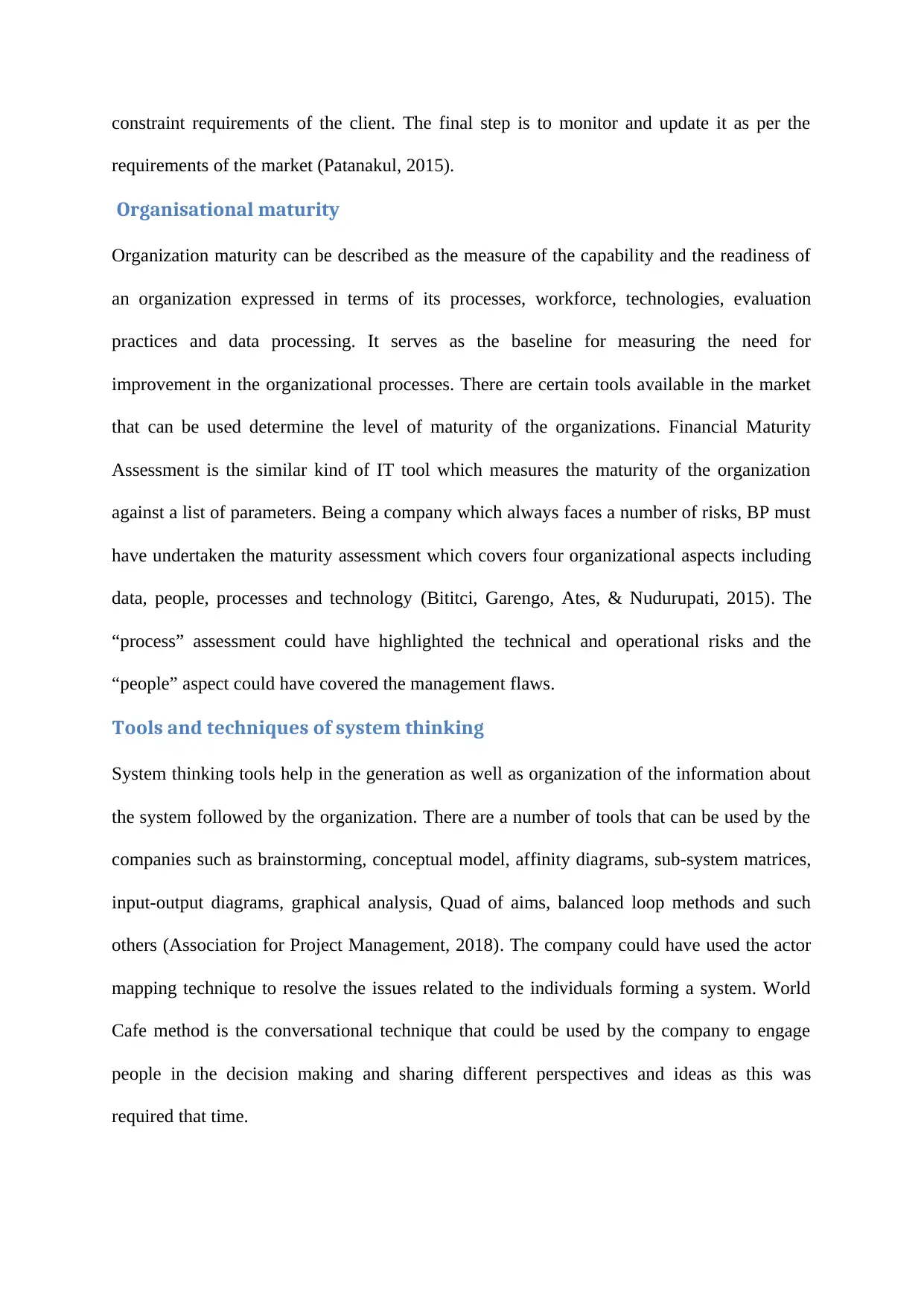
constraint requirements of the client. The final step is to monitor and update it as per the
requirements of the market (Patanakul, 2015).
Organisational maturity
Organization maturity can be described as the measure of the capability and the readiness of
an organization expressed in terms of its processes, workforce, technologies, evaluation
practices and data processing. It serves as the baseline for measuring the need for
improvement in the organizational processes. There are certain tools available in the market
that can be used determine the level of maturity of the organizations. Financial Maturity
Assessment is the similar kind of IT tool which measures the maturity of the organization
against a list of parameters. Being a company which always faces a number of risks, BP must
have undertaken the maturity assessment which covers four organizational aspects including
data, people, processes and technology (Bititci, Garengo, Ates, & Nudurupati, 2015). The
“process” assessment could have highlighted the technical and operational risks and the
“people” aspect could have covered the management flaws.
Tools and techniques of system thinking
System thinking tools help in the generation as well as organization of the information about
the system followed by the organization. There are a number of tools that can be used by the
companies such as brainstorming, conceptual model, affinity diagrams, sub-system matrices,
input-output diagrams, graphical analysis, Quad of aims, balanced loop methods and such
others (Association for Project Management, 2018). The company could have used the actor
mapping technique to resolve the issues related to the individuals forming a system. World
Cafe method is the conversational technique that could be used by the company to engage
people in the decision making and sharing different perspectives and ideas as this was
required that time.
requirements of the market (Patanakul, 2015).
Organisational maturity
Organization maturity can be described as the measure of the capability and the readiness of
an organization expressed in terms of its processes, workforce, technologies, evaluation
practices and data processing. It serves as the baseline for measuring the need for
improvement in the organizational processes. There are certain tools available in the market
that can be used determine the level of maturity of the organizations. Financial Maturity
Assessment is the similar kind of IT tool which measures the maturity of the organization
against a list of parameters. Being a company which always faces a number of risks, BP must
have undertaken the maturity assessment which covers four organizational aspects including
data, people, processes and technology (Bititci, Garengo, Ates, & Nudurupati, 2015). The
“process” assessment could have highlighted the technical and operational risks and the
“people” aspect could have covered the management flaws.
Tools and techniques of system thinking
System thinking tools help in the generation as well as organization of the information about
the system followed by the organization. There are a number of tools that can be used by the
companies such as brainstorming, conceptual model, affinity diagrams, sub-system matrices,
input-output diagrams, graphical analysis, Quad of aims, balanced loop methods and such
others (Association for Project Management, 2018). The company could have used the actor
mapping technique to resolve the issues related to the individuals forming a system. World
Cafe method is the conversational technique that could be used by the company to engage
people in the decision making and sharing different perspectives and ideas as this was
required that time.
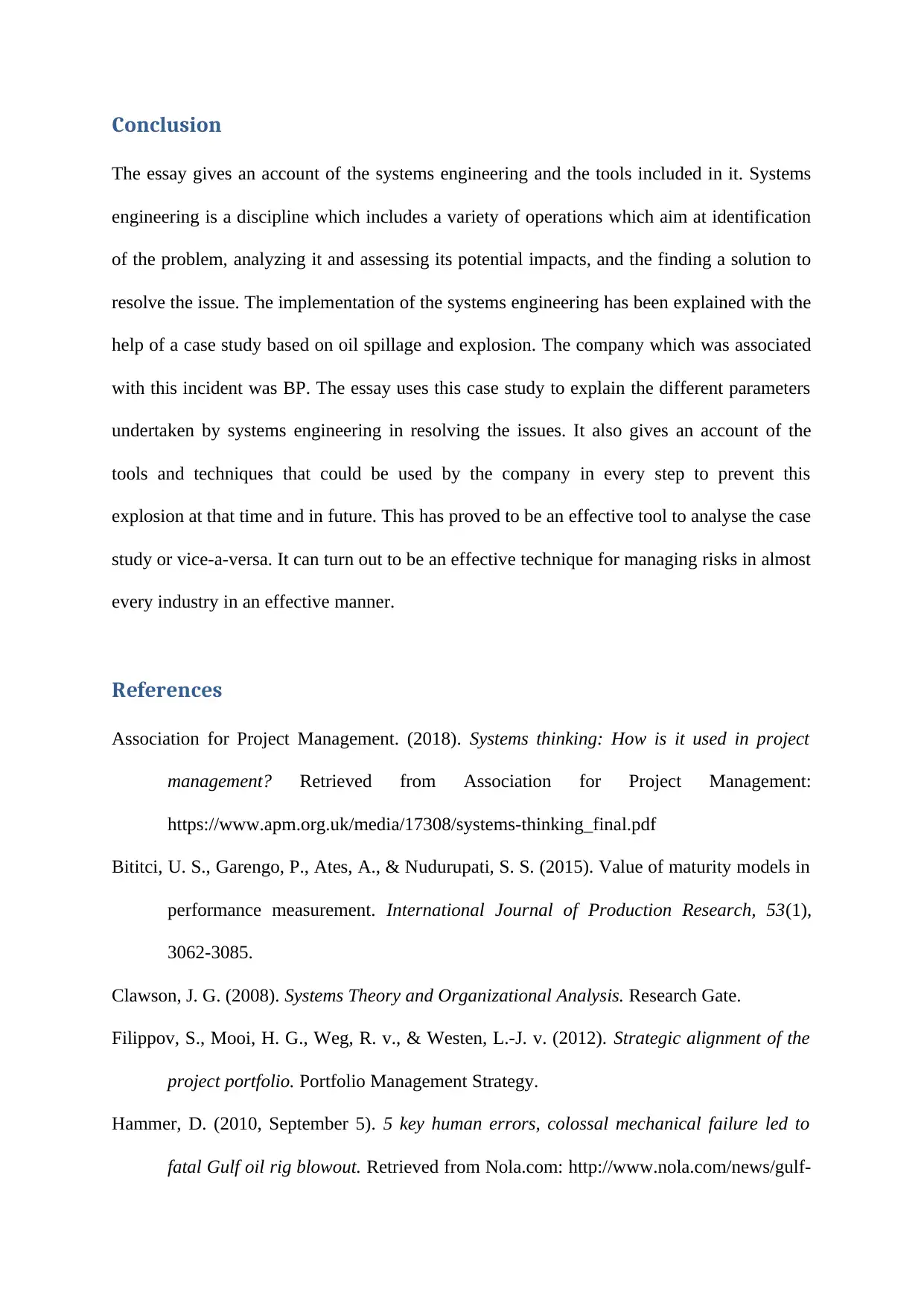
Conclusion
The essay gives an account of the systems engineering and the tools included in it. Systems
engineering is a discipline which includes a variety of operations which aim at identification
of the problem, analyzing it and assessing its potential impacts, and the finding a solution to
resolve the issue. The implementation of the systems engineering has been explained with the
help of a case study based on oil spillage and explosion. The company which was associated
with this incident was BP. The essay uses this case study to explain the different parameters
undertaken by systems engineering in resolving the issues. It also gives an account of the
tools and techniques that could be used by the company in every step to prevent this
explosion at that time and in future. This has proved to be an effective tool to analyse the case
study or vice-a-versa. It can turn out to be an effective technique for managing risks in almost
every industry in an effective manner.
References
Association for Project Management. (2018). Systems thinking: How is it used in project
management? Retrieved from Association for Project Management:
https://www.apm.org.uk/media/17308/systems-thinking_final.pdf
Bititci, U. S., Garengo, P., Ates, A., & Nudurupati, S. S. (2015). Value of maturity models in
performance measurement. International Journal of Production Research, 53(1),
3062-3085.
Clawson, J. G. (2008). Systems Theory and Organizational Analysis. Research Gate.
Filippov, S., Mooi, H. G., Weg, R. v., & Westen, L.-J. v. (2012). Strategic alignment of the
project portfolio. Portfolio Management Strategy.
Hammer, D. (2010, September 5). 5 key human errors, colossal mechanical failure led to
fatal Gulf oil rig blowout. Retrieved from Nola.com: http://www.nola.com/news/gulf-
The essay gives an account of the systems engineering and the tools included in it. Systems
engineering is a discipline which includes a variety of operations which aim at identification
of the problem, analyzing it and assessing its potential impacts, and the finding a solution to
resolve the issue. The implementation of the systems engineering has been explained with the
help of a case study based on oil spillage and explosion. The company which was associated
with this incident was BP. The essay uses this case study to explain the different parameters
undertaken by systems engineering in resolving the issues. It also gives an account of the
tools and techniques that could be used by the company in every step to prevent this
explosion at that time and in future. This has proved to be an effective tool to analyse the case
study or vice-a-versa. It can turn out to be an effective technique for managing risks in almost
every industry in an effective manner.
References
Association for Project Management. (2018). Systems thinking: How is it used in project
management? Retrieved from Association for Project Management:
https://www.apm.org.uk/media/17308/systems-thinking_final.pdf
Bititci, U. S., Garengo, P., Ates, A., & Nudurupati, S. S. (2015). Value of maturity models in
performance measurement. International Journal of Production Research, 53(1),
3062-3085.
Clawson, J. G. (2008). Systems Theory and Organizational Analysis. Research Gate.
Filippov, S., Mooi, H. G., Weg, R. v., & Westen, L.-J. v. (2012). Strategic alignment of the
project portfolio. Portfolio Management Strategy.
Hammer, D. (2010, September 5). 5 key human errors, colossal mechanical failure led to
fatal Gulf oil rig blowout. Retrieved from Nola.com: http://www.nola.com/news/gulf-
⊘ This is a preview!⊘
Do you want full access?
Subscribe today to unlock all pages.

Trusted by 1+ million students worldwide
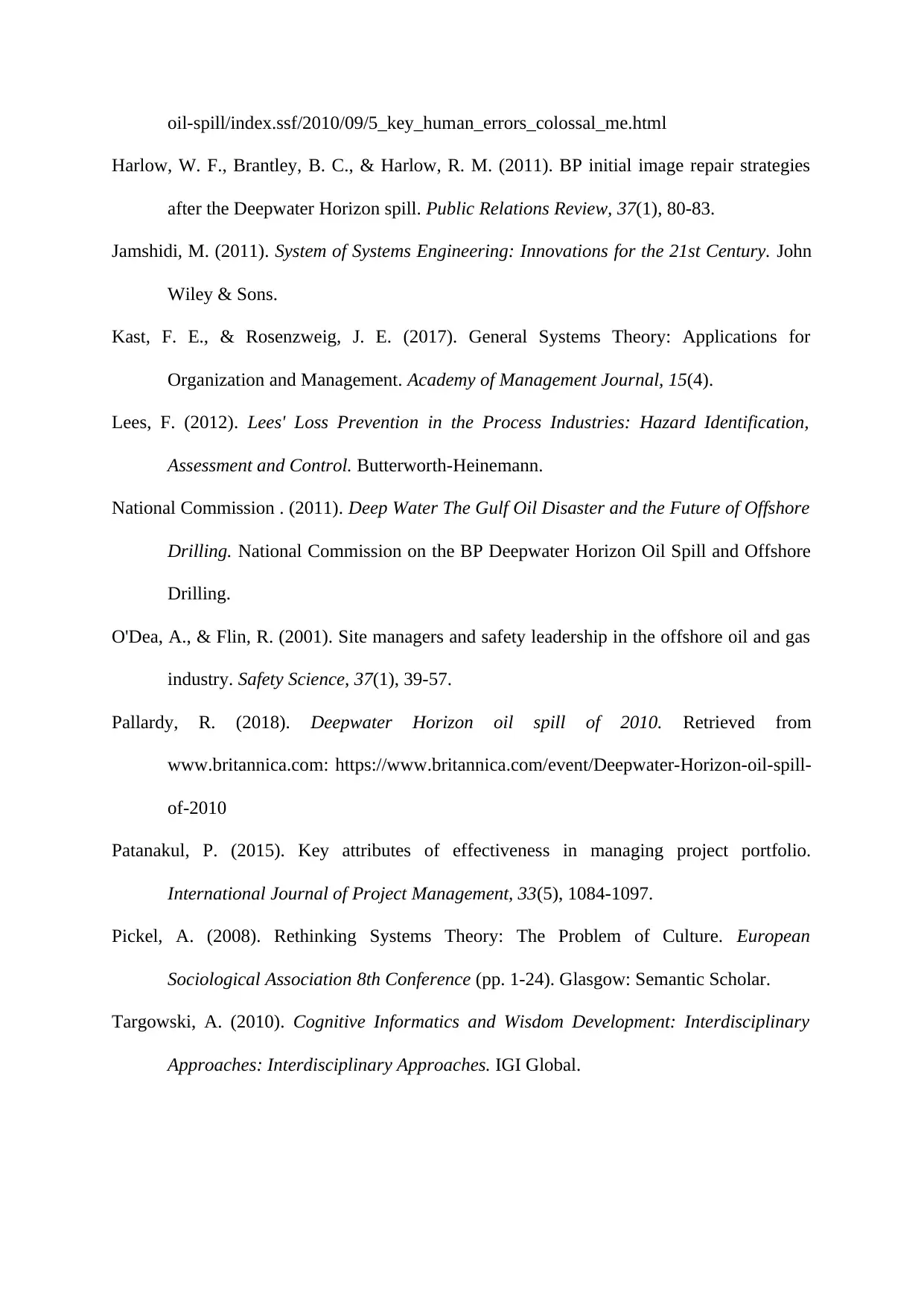
oil-spill/index.ssf/2010/09/5_key_human_errors_colossal_me.html
Harlow, W. F., Brantley, B. C., & Harlow, R. M. (2011). BP initial image repair strategies
after the Deepwater Horizon spill. Public Relations Review, 37(1), 80-83.
Jamshidi, M. (2011). System of Systems Engineering: Innovations for the 21st Century. John
Wiley & Sons.
Kast, F. E., & Rosenzweig, J. E. (2017). General Systems Theory: Applications for
Organization and Management. Academy of Management Journal, 15(4).
Lees, F. (2012). Lees' Loss Prevention in the Process Industries: Hazard Identification,
Assessment and Control. Butterworth-Heinemann.
National Commission . (2011). Deep Water The Gulf Oil Disaster and the Future of Offshore
Drilling. National Commission on the BP Deepwater Horizon Oil Spill and Offshore
Drilling.
O'Dea, A., & Flin, R. (2001). Site managers and safety leadership in the offshore oil and gas
industry. Safety Science, 37(1), 39-57.
Pallardy, R. (2018). Deepwater Horizon oil spill of 2010. Retrieved from
www.britannica.com: https://www.britannica.com/event/Deepwater-Horizon-oil-spill-
of-2010
Patanakul, P. (2015). Key attributes of effectiveness in managing project portfolio.
International Journal of Project Management, 33(5), 1084-1097.
Pickel, A. (2008). Rethinking Systems Theory: The Problem of Culture. European
Sociological Association 8th Conference (pp. 1-24). Glasgow: Semantic Scholar.
Targowski, A. (2010). Cognitive Informatics and Wisdom Development: Interdisciplinary
Approaches: Interdisciplinary Approaches. IGI Global.
Harlow, W. F., Brantley, B. C., & Harlow, R. M. (2011). BP initial image repair strategies
after the Deepwater Horizon spill. Public Relations Review, 37(1), 80-83.
Jamshidi, M. (2011). System of Systems Engineering: Innovations for the 21st Century. John
Wiley & Sons.
Kast, F. E., & Rosenzweig, J. E. (2017). General Systems Theory: Applications for
Organization and Management. Academy of Management Journal, 15(4).
Lees, F. (2012). Lees' Loss Prevention in the Process Industries: Hazard Identification,
Assessment and Control. Butterworth-Heinemann.
National Commission . (2011). Deep Water The Gulf Oil Disaster and the Future of Offshore
Drilling. National Commission on the BP Deepwater Horizon Oil Spill and Offshore
Drilling.
O'Dea, A., & Flin, R. (2001). Site managers and safety leadership in the offshore oil and gas
industry. Safety Science, 37(1), 39-57.
Pallardy, R. (2018). Deepwater Horizon oil spill of 2010. Retrieved from
www.britannica.com: https://www.britannica.com/event/Deepwater-Horizon-oil-spill-
of-2010
Patanakul, P. (2015). Key attributes of effectiveness in managing project portfolio.
International Journal of Project Management, 33(5), 1084-1097.
Pickel, A. (2008). Rethinking Systems Theory: The Problem of Culture. European
Sociological Association 8th Conference (pp. 1-24). Glasgow: Semantic Scholar.
Targowski, A. (2010). Cognitive Informatics and Wisdom Development: Interdisciplinary
Approaches: Interdisciplinary Approaches. IGI Global.
Paraphrase This Document
Need a fresh take? Get an instant paraphrase of this document with our AI Paraphraser
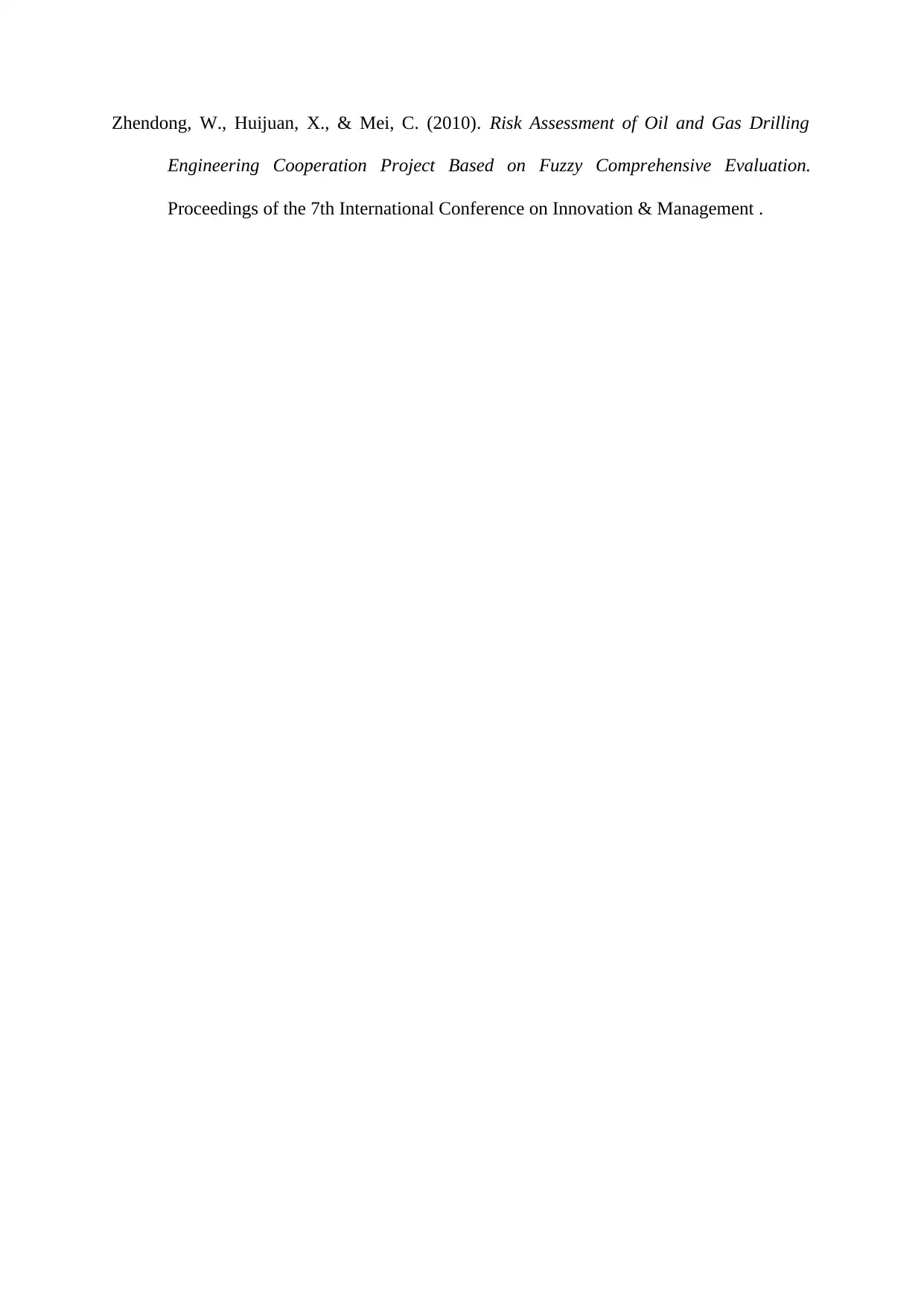
Zhendong, W., Huijuan, X., & Mei, C. (2010). Risk Assessment of Oil and Gas Drilling
Engineering Cooperation Project Based on Fuzzy Comprehensive Evaluation.
Proceedings of the 7th International Conference on Innovation & Management .
Engineering Cooperation Project Based on Fuzzy Comprehensive Evaluation.
Proceedings of the 7th International Conference on Innovation & Management .
1 out of 11
Related Documents
Your All-in-One AI-Powered Toolkit for Academic Success.
+13062052269
info@desklib.com
Available 24*7 on WhatsApp / Email
![[object Object]](/_next/static/media/star-bottom.7253800d.svg)
Unlock your academic potential
Copyright © 2020–2025 A2Z Services. All Rights Reserved. Developed and managed by ZUCOL.





